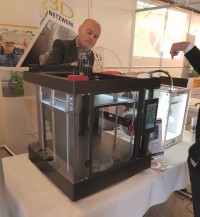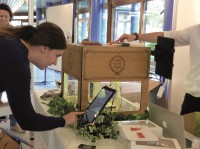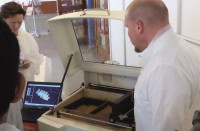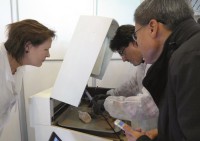ZDS - Zentralfachschule der Deutschen Süßwarenwirtschaft e. V.
Additive manufacturing in the food sector: solutions for the future
The ZDS – Zentralfachschule der Deutschen Süßwarenwirtschaftorganized the first 3D printing congress for the confectionary and snack industry. Experts from science and technology presented interesting solutions for the use of additive manufacturing using 3D printings.
Chocolate from the printer, elaborately decorated cakes with delicate sugar decorations, personalization, food for certain diets – hardly a day passed during the last months without having published an innovation in 3D printing. But how can industry use this new technology? What can be put into practice and what is still a vision of the future? These questions were answered at the first congress for additive manufacturing and 3D food printing recently held at the ZDS – Zentralfachschule der Deutschen Süßwarenwirtschaft in Solingen/Germany.
On the first day of the conference, the focus was on additive production, especially in the area of food machine construction. Prof. Andreas Gebhardt of the GoetheLab for Additive Manufacturing, Aachen/Germany, gave an introduction of the various printing processes and their application areas. While manufacturing on the home desktop by the end user and bioprinting are still at an early technological stage, the development status of additive manufacturing technologies for the industry is already well advanced in many fields of application. This was underlined by Prof. Gebhardt with a study of Credit Suisse which shows a strong positive development for the additive manufacturing sector. In 2009, the turnover amounted to $ 2 bn, and in 2016, it had already risen to more than $ 7 bn. As a forecast, a yearly double-digit growth for the coming years is to be expected.
The fact that 3D technology, and in particular 3D printing, is not only a technical gimmick, but is also used in many areas in a time-saving and cost-saving manner, had also been proved by Dr Werner Koch from the 3D network NRW (North Rhine-Westphalia). As an example, he quoted the spare part production of tool changers. The costs for a mechanical production out of aluminum are about € 990, whereas by means of 3D printing of nylon and Kevlar the costs are € 78. The working time needed for the mechanical production of the spare part is about 72 hours, while the 3D printing process takes only 54 hours. Other advantages of the spare parts production are obvious: custom-tailored, individual products that can be manufactured at any time at any place of the world. “Customization” in conjunction with 3D printing is no longer only associated with the single, individual product – meanwhile, you might call it “mass customization”.
3D printing completes conventional manufacturing
Prof Mirko Meboldt from ETH Zurich focused on the question of how to get started with 3D printing and generate added value. Using an example of chocolate packaging equipment, he showed how a company in this sector produces customer-tailored format parts more cost-effectively using 3D printing. The standard packaging machines are adjusted by means of so-called format parts to the specific characteristics of the different chocolate manufacturers. If one of these format parts fails, long procurement times and manual on-site adjustments must be expected. By means of plastic 3D printing, the spare parts can be manufactured quickly and adjusted more easily and precisely. Also in this context, synergies and thinking in “digital” process chains play a decisive role: not a printed spare part generates a value added, but many individual customer-specific parts.
Going further, you can use 3D technologies across the entire process chain: from online ordering to outsourced 3D printing to delivery. Advantage: no storage costs, no manual preparation of tools and no manual adjustment to manufacture the customer-specific component.
Although it certainly was not possible to cover all questions and topics of additive production on the first day of the conference, the conclusion is: 3D printing will not replace conventional production, but complete it. There isn’t “the” additive manufacturing or “the” technology – the important factor is the application field. In order to successfully use 3D printing in additive production, it is necessary to identify which components fulfil the requirements for 3D production, to think in process chains and to use the synergies of the individual 3D technologies.
Dr Kjeld van Bommel (TNO Netherlands), an international expert in the field of 3D food printing, presented the second congress day according to the topic “3D foodstuff: potentials for the production of confectionery and snacks”. In his own lecture he showed the various possibilities in 3D foodstuff printing. The most famous application is the production of individual pasta. In collaboration with Barilla, TNO developed a printer that uses a mixture of flour and water to produce personalized noodles in less than two minutes.
Processes need to be completely redesigned
Dr van Bommel showed that 3D foodstuff printing can realize many things – however, new ways have to be tried. The use and design of raw materials and production chains must be completely redesigned for an “industrialized” solution.
A true firework was provided by Melissa Snover from the Magic Candy Factory, a British subsidiary of Katjes. In her lecture, she showed how an idea and the associated sophisticated technology create a flourishing start-up. For the Magic Candy Factory printers, Melissa Snover uses the classic FDM principle with customized hardware and software. Yet, the company’s success is not just due to the sophisticated 3D printing technology – Melissa Snover has recognized the trend of our time: today’s customers want their products individually and quickly available. The concept of the Magic Candy Factory is based on this: a product is personalized and can be ordered with just one mouse-click. In addition, the products can be printed “live” in various Katjes stores.
Those who expected “ready-made solutions à la carte” at the congress were maybe disappointed. Processes need to be completely redesigned and raw materials and recipes have to fulfil completely new requirements for 3D printing. But this is what all the participants got on this congress: new inspirations, some new business ideas and an insight into a new, promising technology, not least through demonstrations by Melissa Snover or Jason Mosbrucker, who presented his powderbed printer.
On 17 May 2018, there will be a follow up seminar with the topic “Update: 3D Technology” at the ZDS. •




